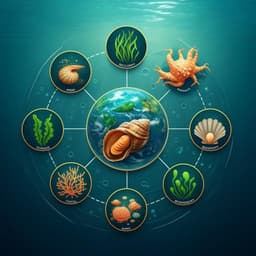
Environmental Studies and Forestry
An interactive model to assess pathways for agriculture and food sector contributions to country-level net-zero targets
G. Baudry, L. Costa, et al.
Discover how the ARISE interactive model can reshape countries' food and agriculture systems to meet net-zero ambitions by 2050. This cutting-edge research, conducted by Gino Baudry, Luis Costa, Lorenzo Di Lucia, and Raphael Slade, explores innovative pathways towards sustainability while addressing crucial trade-offs in agriculture.
~3 min • Beginner • English
Introduction
The paper addresses how the UK food and agriculture sector can contribute to national net-zero targets by 2050 while simultaneously tackling broader sustainability challenges (nitrogen and phosphorus cycles, biodiversity loss, water quality, health). The authors note that since the Green Revolution, intensification increased productivity and reduced land needs, but caused significant environmental impacts and health concerns. The UK agriculture sector contributes substantially to greenhouse gas emissions (notably nitrous oxide) and to water pollution, and relies on imports (e.g., soy for feed) with global deforestation implications. Most existing pathways toward 2050 net-zero emphasize sustainable intensification and large dietary shifts, potentially overlooking agroecological options and trade-offs. The research aims to present and apply ARISE, an interactive model enabling stakeholders to co-design and explore internally consistent pathways, quantify trade-offs, and compare an agroecological pathway for the UK (co-developed with the European Environmental Bureau) against alternative literature and government pathways.
Literature Review
The authors situate their work within literature that often privileges sustainable intensification for agri-food decarbonization, with assumptions of significant yield increases and technological adoption (genomics, GM, precision feeding, inhibitors, electrification, bioenergy with CCS). They highlight gaps in detailed, agroecology-centered national pathways and in integrated treatment of multiple sustainability objectives (climate, biodiversity, nutrients, water, health). They reference the UK’s Sixth Carbon Budget, FAO scenarios to 2050, lifestyle/diet studies (e.g., EAT-Lancet, flexitarian/healthy diets), and critiques of technology-optimistic pathways and BECCS feasibility. The literature indicates dietary change is disproportionately influential for meeting climate targets, but evidence on agroecology’s mitigation potential is underrepresented in policy scenarios. This motivates developing and testing an alternative, stakeholder-driven agroecology pathway using ARISE.
Methodology
The study introduces ARISE (AgRIculture and food SystEm interactive model), an interactive, quantitative, system model linking key UK food system mechanics from fork to farm. ARISE enables users to set ambition levels for up to ~200 levers across social behaviors, production systems, land management, trade, bioenergy, and policy, then computes impacts on food supply, land, nitrogen balance, inputs, LULUCF carbon dynamics, GHG emissions, and SDG indicators. The model was calibrated using historical data (primarily 1961–2017 FAOSTAT for supply/production/yields/inputs; Eurostat and UK stats for energy and bioenergy; UNFCCC inventories for LULUCF carbon; UN population for demography). Emission factors are partly endogenous (land dynamics) or exogenous (e.g., enteric fermentation).
A co-design process with the European Environmental Bureau (EEB) was conducted remotely due to COVID-19: (1) a workshop introduced ARISE, its interface (Transition Pathway Explorer), and lever ambition levels; gathered feedback to refine features (notably nitrogen cycle and agroforestry). (2) Iterative bilateral sessions translated EEB narratives (e.g., agroecology, self-sufficiency, reduced livestock density, diet shifts) into model inputs, ran simulations (~5 minutes per run), and adjusted narratives to resolve conflicts (e.g., maintaining agricultural land area while achieving diet and self-sufficiency goals). The final pathway reduced the extent of diet change to align with WHO recommendations while retaining agroecological practices, grass-fed livestock prioritization, phasing out imported soy/palm cakes, and increasing domestic feed protein from rapeseed. Land management included hedgerows and tree planting (silvopasture), no-till and cover crops on cropland. The nitrogen balance targets manure and legume fixation replacing synthetic fertilizers, aiming for high nitrogen use efficiency. Pre-saved scenarios (e.g., BAU, Look-Up) exist for comparisons. Outputs were explored via the ARISE pathway explorer (Power BI).
Key Findings
- Social behaviors: Assuming UN demography to 2050, a 25% reduction in obesity prevalence per age/gender class and adoption of a healthier diet reduce average energy requirement to 2330 kcal/cap/day (−5.7% vs 2017). Diet composition by 2050: meat 106 g/cap/day (13 g red meat, 73 g poultry, 17 g pig), dairy ~341 g/cap/day (almost halved), eggs 55 g/cap/day (+80%), fruits 455 g (+26%), vegetables 275 g (+9%), oil crops 40 g (+~186%), pulses 18 g (+~5×), starchy roots 200 g (−28%). Alcoholic beverages and stimulants drop to 16 g and 186 g/cap/day, respectively. Household food waste falls by 47% in volume (51% in energy) vs 2015. Overall food supply declines ~15% by 2050 vs 2017 despite +11% population; meat −50%, dairy and eggs −36%; oil crops +186%, pulses +87%; vegetable oils −12%; stimulants −36%; alcoholic beverages −23%.
- Livestock: Shift to grass-fed systems; pasture contribution to feed up by 23%; grazing density from 0.98 to 0.9 LSU/ha. Imported soy/palm cakes phased out by 2050, replaced with UK rapeseed cake. Silvopasture with 50 m hedgerow/ha and tree planting sequesters ~0.05 tC/ha (hedges) and 0.138 tC/ha (trees). Livestock yields: ruminants +20%, broilers +13%; dairy −16%, pigs −9%, laying poultry −3.5%. Meat self-sufficiency achieved; milk and eggs reach historical maximum self-sufficiency (1.33 and 1.13). Domestic animal-based production −24% while domestic supply −40% vs 2017, reflecting self-sufficiency and diet change. Livestock population −23% by 2050; poultry broilers rise to ~60% of slaughtered animals; non-dairy cattle fall to ~4%. Compound feed supply drops from 18 Mt (2017) to 7 Mt (2050). Pasturelands decrease only 11% by 2050, with meadows partly spared for biodiversity (Aichi target 11).
- Crops and nitrogen: Agroecological practices adopted; phase-out of synthetic fertilizers and pesticides. Nitrogen input-output ratio reaches ~109% (N-use efficiency ~92%) via manure and legume fixation (rotations/intercropping). No-till and cover crops add ~0.1 and 0.16 tC/ha, respectively; hedgerows deployed on cropland. Conservative yield changes by 2050 vs 2017: cereals −27%; oil crops −25% to −45%; fruits −42%; pulses −38%; starchy roots −35%; vegetables −10%. UK self-sufficiency for indigenous crop commodities achieved; domestic crop production −~33% (driven largely by −11 Mt feed demand). Wheat and starchy roots reach self-sufficiency (from 0.94/0.91), pulses reach 1.76. Harvested area +10% vs 2017 (back to ~1990 level) due to lower yields.
- GHG emissions and sinks: Food and agriculture GHG emissions roughly halve by 2050 vs 2017, with net-zero reached around 2040 under an S-curve deployment of agroecological practices. By 2050 the sector becomes a net sink of about −14 MtCO2eq. Drivers include ~50% reduction in manure-related emissions, ~60% reduction in enteric fermentation (shift from ruminants to monogastrics), and ~90% reduction in fertilizer-related emissions. Carbon sequestration increases via trees on grassland (~3.1 MtC ≈ 12.6 MtCO2), hedgerows on grassland (~0.56 MtC ≈ 2.3 MtCO2), cover crops (~1.1 MtC ≈ 4.3 MtCO2), no-till (~0.6 MtC ≈ 2.7 MtCO2), and hedgerows on cropland (~0.3 MtC ≈ 1.3 MtCO2). Drained organic soils emissions were not addressed.
- Comparative insights: The EEB pathway achieves ~−60 MtCO2eq relative to 2017, compared to ~50 and −80 MtCO2eq for CCC Balanced Net Zero and Tailwinds (excluding extra BECCS), and −72 MtCO2eq for Zero Carbon Britain. All rely on significant behavioral change; EEB’s behavior shifts are moderate relative to some intense assumptions (e.g., 58% meat/dairy cut and 92% beef cut in Zero Carbon Britain). Unlike sustainable intensification pathways that assume very ambitious yield increases (+65% to +95% for cereals) and large-scale BECCS (52–97 MtCO2eq/yr removals), the EEB pathway emphasizes agroecology, biodiversity, hedgerows/tree planting, and conservative bioenergy (no BECCS; biomass ~2017 level ~160 TWh).
Discussion
The findings demonstrate that an agroecology-focused pathway can contribute substantially to UK net-zero targets while simultaneously addressing multiple sustainability goals (biodiversity, nutrient cycles, water quality, health) and reducing reliance on imported feed and synthetic inputs. By co-designing with stakeholders using ARISE, the study reveals and quantifies trade-offs among diet shifts, self-sufficiency, livestock density, land conservation, and production yields. The EEB pathway achieves net-zero around 2040 and a net sink by 2050 through combined demand-side changes and land-based sequestration (hedgerows, silvopasture, cover crops, no-till, reforestation), without depending on optimistic yield assumptions or large-scale BECCS. Compared with sustainable intensification pathways, the agroecological route redistributes efforts toward behavior and land management rather than advanced technologies and very high yield gains, potentially lowering risks of mal-adaptation or overreliance on uncertain technologies. The approach underscores that different stakeholder priorities (e.g., biodiversity vs. bioenergy) lead to different allocations of spared land and technology choices, and ARISE provides a common platform to explore these choices and build consensus.
Conclusion
This paper presents ARISE, an interactive model enabling stakeholders to co-design and evaluate internally consistent agri-food pathways, and applies it to develop an EEB-led agroecological pathway for the UK. The case study shows that with moderate diet shifts aligned to WHO guidance, reduced waste, agroecological practices, enhanced carbon sequestration via agroforestry and soil practices, and improved self-sufficiency, the UK food and agriculture system can reach net-zero around 2040 and act as a net sink by 2050. The pathway addresses multiple sustainability objectives beyond GHG mitigation, offering a conservative alternative to technology-optimistic sustainable intensification scenarios.
Future work includes: (1) expanding ARISE accessibility via a web tool; (2) integrating economic and true cost-of-food accounting to capture externalities and supply chain dependencies; (3) enhancing representation of health–diet dynamics and biodiversity benefits; and (4) developing evidence-based policy packages to enable ambitious, feasible transitions.
Limitations
- Stakeholder diversity means no single best pathway; trade-offs depend on values and priorities. ARISE facilitates exploration but does not prescribe solutions.
- The current ARISE tool requires some IT skills; a web-based version is under development to improve accessibility.
- Economic/cost modules are not yet implemented; a true cost-of-food methodology is planned to capture environmental, social, health externalities and dependencies.
- Some impacts are not fully implemented (e.g., detailed health–diet dynamics, biodiversity benefits).
- Scenario assumptions did not explicitly address emissions from drained organic soils; peatland restoration was not included in the EEB pathway.
- Results depend on assumed adoption rates and conservative yield and sequestration estimates; uncertainties remain regarding future climate impacts, behavioral change feasibility, and policy effectiveness.
Related Publications
Explore these studies to deepen your understanding of the subject.







